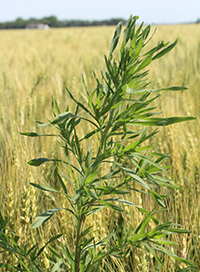Scientific Name
Bassia scoparia (formerly known as Kochia scoparia)
Common Names
fireweed, summer cypress, Mexican firebush, sometimes referred to as tumbleweed
Overview
Kochia is one of the most troublesome weeds across the Great Plains and western United States. It can be found in crop fields, pastures, rangeland, roadsides, ditch banks and wastelands. Left uncontrolled, kochia can cause severe yield reductions in crops.

Identifying Characteristics
- Kochia is a taprooted annual herbaceous flowering plant that typically grows from 1 to 6 feet tall.
- Stems are erect and spreading, branched from the base, usually soft-hairy but occasionally smooth, usually yellowish-green to green, and often turn red with maturity.
- Leaves of the plant are alternate and lance-shaped, 0.5 to 2 inches long, and have fringed hairs on the margins. The upper surface of the leaf is usually smooth, and the lower surface usually is covered with soft hairs.
- Kochia flowers are inconspicuous and greenish and form short, dense, terminal, bracted spikes. Flowering generally occurs from July to September.
- Kochia reproduces only by seed with more than 14,000 seeds produced per plant. Seeds germinate in the spring and have little or no seedback viability. They either germinate or decay in one year.
Prominence
- Kochia grows wild throughout most of the northern United States.
- The plant has become a serious drought-resistant weed in the Plains states. It can produce forage with as little as 6 inches of annual rainfall and is relatively cold-hardy.
Resistance Status
- Kochia has an imperfect flower that allows cross-pollination, increasing the potential for greater incidence of herbicide resistance.
- Populations of kochia that are resistant to atrazine (photosystem II inhibitor) were first reported in 1976. Kochia resistance to sulfonylurea herbicides (ALS inhibitors) was first reported in 1987 and is now considered widespread.
- Kochia populations resistant to glyphosate were first reported in 2007 in Kansas. Since 2007, glyphosate-resistant kochia has spread throughout the Great Plains and Western United States.
Tips for Managing Resistance
- Diverse crop rotation has proven effective for managing control of kochia. In regions where wheat is the predominant crop and crop rotation is not always an option, the use of diversified chemistries with different modes of action is recommended.
- Using both preemergence (soil residual) and postemergence herbicides with multiple sites of action is an effective management strategy.
- Using multiple herbicide application times (burndown, preplant, pre- and postemergence, and postharvest), in-crop or fallow herbicides are the most effective means to control multiple flushes of kochia during the season.
Treatment Recommendations
PerfectMatch®, WideMatch®, OpenSky® and GoldSky® herbicides offer effective control of kochia. Consult with your agribusiness retailer or Corteva Agriscience field scientist or sales representative for application rate and timing.
Sources
Kochia: a weed to watch. 2016.
Jha, P., K. McVay, A. Varanasi, and V. Kumar. 2013. Glyphosate-resistant kochia in Montana: Herbicide recommendations and best management practices for growers. Montana State University Extension. Research Bulletin No. 4602.
Schwinghamer, T.D., and R.C. Van Acker. 2008. Emergence timing and resistance of kochia. Weed Science. 56(1):37-41.
Heap, I. The international survey of herbicide resistant weeds.
The More You Grow
Find expert insights on agronomics, crop protection, farm operations and more.